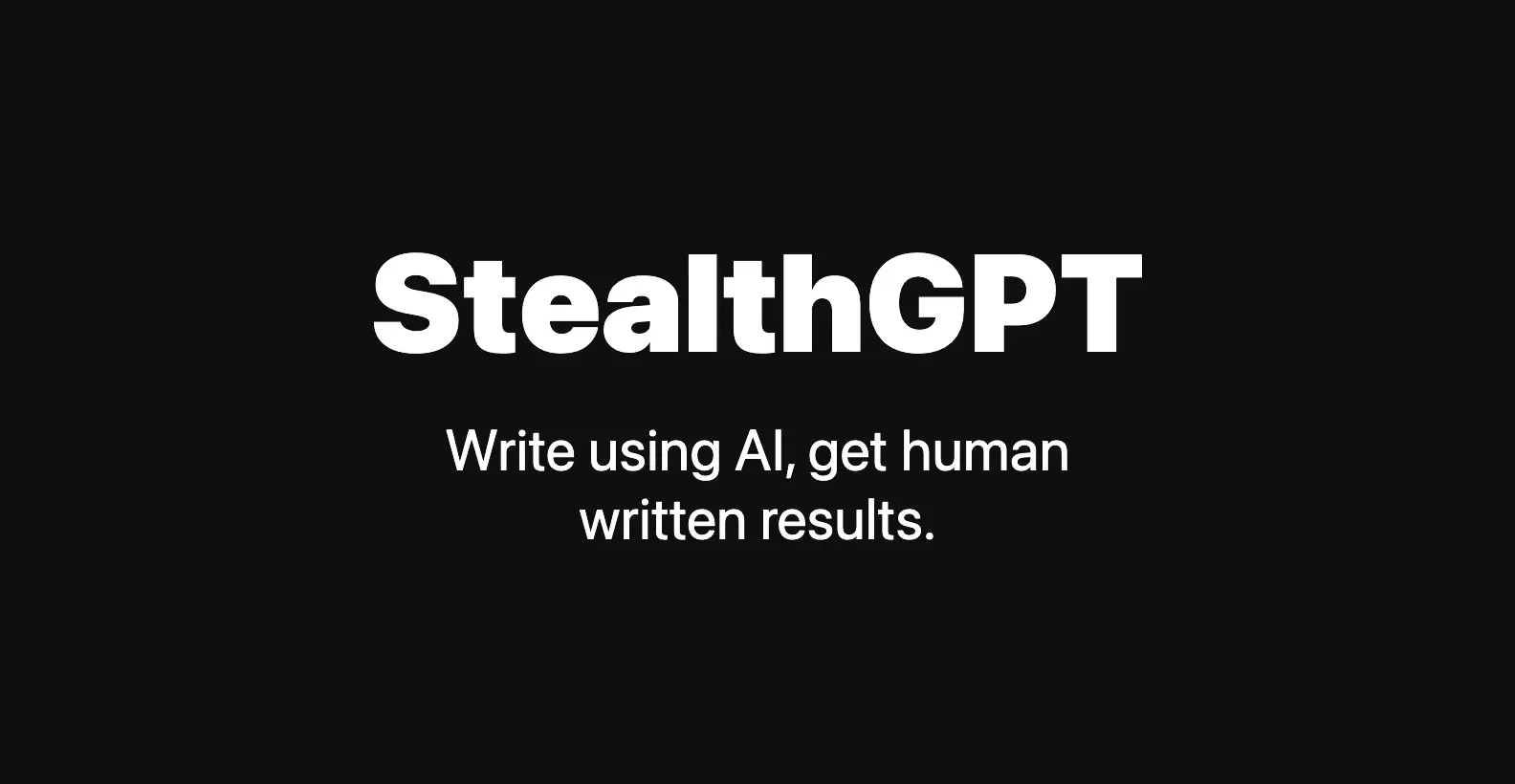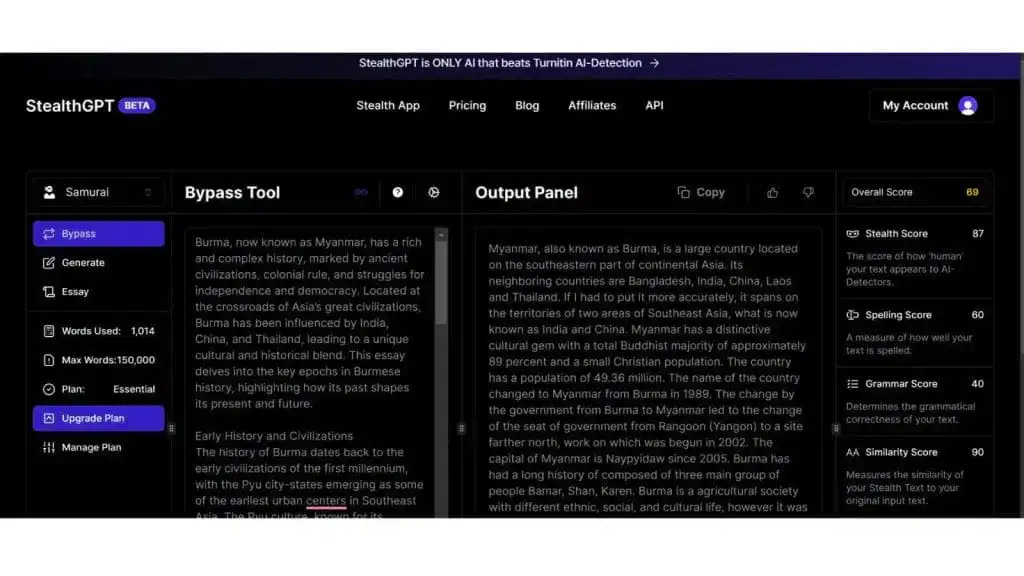How to Outsmart AI Detectors: Lessons from StealthGPT

Vivi Carter · 19, July 2025
In an age where AI-generated content is flourishing, a new niche has emerged: the development of tools designed to "disguise" AI-generated text. These products aim to bypass AI detection systems, such as GPTZero and Turnitin, offering users a way to appear undetectable. One example of a buzzworthy entrant in this space is StealthGPT, a SaaS product intended to make AI-generated text appear as if written by humans. Today, we’ll examine the mechanics, market positioning, and challenges of this controversial product, as well as what entrepreneurs can learn from its story.

What Is StealthGPT?
At its core, StealthGPT is marketed as a "text anonymizer for AI-generated content." It boasts a suite of tools that modifies text created by AI systems like ChatGPT so it can bypass detection software. The goal? Ensure that AI-generated content "hides in plain sight." Its features cater to users like students, marketers, SEO professionals, and content creators who want the efficiency of AI without triggering penalties from AI detection algorithms.
The product has gained notable traction, recording 400,000+ monthly website visits and an estimated monthly revenue exceeding $10,000. But plenty of skepticism surrounds StealthGPT, as critics question whether the product can actually deliver what it promises.
Core Features
Here’s what StealthGPT offers, packaged as a productivity "toolkit":
Stealth Writer:
Generates "undetectable" text with claims of passing AI-identification tools. Its use cases include essays, emails, and blogs.
AI Humanizer:
Refines existing AI-generated content to eliminate machine-readable patterns.
Photo to Answer:
Converts images (like homework problems) into text answers.
SEO Writer:
Crafts search engine-optimized blog content that purportedly evades detection while boosting online visibility.
AI Checker:
Built-in AI text detection tool for a self-evaluation step.
PDF Summarizer:
An assistant for extracting summaries and key insights from PDF documents.
StealthGPT claims to use proprietary AI trained on human-authored texts and introduces randomization techniques, including slight grammar imperfections, to emulate genuine human writing. But as we dive deeper, the question is whether these "undetectable" outputs are convincingly high-quality—and, more importantly, worth the subscription fee.
Target Audience: Who’s Using StealthGPT?
StealthGPT’s audience primarily comprises groups concerned about AI detection consequences:
Students:
College and high school students likely dominate its user base. The product’s marketing strategy—featuring terms like "essay" and "Turnitin-friendly"—heavily appeals to individuals wanting to submit AI-assisted assignments without fear of repercussion.
SEO Professionals & Content Marketers:
These professionals seek efficiency in producing large-scale content (e.g., blog articles) without penalty from search engines or other platforms flagging AI-generated material.
Business Professionals:
Marketing copy, client reports, and email communications may utilize StealthGPT as a shortcut while avoiding detection pitfalls.
While these groups are valuable niches, their reliance on StealthGPT hinges on whether the tool successfully balances detection evasion with readability and reliability.

Product Experience: Strengths and Weaknesses
1. Website & Onboarding
StealthGPT’s landing page is straightforward, focusing on key value propositions such as "undetectability" and seamless workflows. Unlike bare-bones efforts by indie developers, the site includes core SaaS product elements: FAQs, guides, pricing tiers, and separate SEO-targeted feature pages.
Notably, the product also comes with accompanying apps/plugins, a sign that it’s run by a professional development team rather than inexperienced founders testing a hobby idea.
2. Pricing
Like many SaaS tools, StealthGPT adopts a tiered subscription model:
- Essential: Basic access to the "text anonymizer."
- Pro: Advanced "stealth options" like custom word limits or enhanced SEO writing tools.
- Business & Enterprise: Higher-tier plans with unlisted features and team collaboration capabilities.
- Add-ons: Optional upgrades include daily credit increases, such as the "Samurai Addon."
StealthGPT differentiates itself by testing aggressive pricing tactics—running lifetime subscriptions on platforms like AppSumo (popular among startups) to generate cash flow. While it’s a common growth move, maintaining long-term service quality poses a serious challenge for lifetime subscription models.
Does It Deliver? Key Problems and User Criticism
StealthGPT boldly claims undetectability, but real-world results tell a different story. User feedback highlights these critical flaws:
Output Quality Issues:
- Users frequently describe StealthGPT's generated text as "garbled," "poorly constructed," or "childish."
- While it may evade detection tools, humans can easily identify awkward phrasing and logical gaps, undermining credibility.
Detection Inconsistencies:
- Despite its promises, StealthGPT struggles with advanced tools like Turnitin or Originality.ai.
- Reviews highlight that even after using the "high stealth" mode, detection rates remain as high as 94%.
Readability vs. Detection Evasion:
- Many users report that while StealthGPT lowers detection scores, the tradeoff is a decline in usability.
- Fixing poor output often requires extensive manual editing, which eliminates the promised time savings.
Polarized User Reviews:
- Some users find limited success within specific narrow contexts, such as simple writing tasks.
- However, large-scale users (students, SEO professionals) describe mixed or outright disappointing results.
Growth Strategies: Clever Marketing for Early Traction
StealthGPT adopted a quintessential fast-mover approach to tackle the AI-detection evasion niche. Here’s a closer look at its growth strategy:
1. SEO-Driven Content Marketing
SEO is StealthGPT’s primary traffic source, driving 64% of site visitors. Through relentless execution, it captured numerous high-intent keywords like:
- "undetectable AI"
- "bypass AI detection tools"
- "beat Turnitin AI"
Additionally, the company frequently publishes competitor comparison content, often skewing claims toward its perceived superiority. While this aggressive strategy borders on "SEO overkill," it succeeds in dominating niche keyword traffic.
Takeaway: Thoughtful SEO can expand audience reach, but overpromising risks backlash if products underdeliver.
2. Affiliate Marketing
StealthGPT’s affiliate program offers a 25% lifetime commission, incentivizing creators to promote them on blogs and review sites. It’s a smart choice for niche products that can’t easily advertise on mainstream platforms like Google or Facebook.
3. Community Building
The team built a Discord server to engage directly with end users, gathering reactions and fostering loyalty. However, users accused moderators of suppressing negative feedback—undermining its transparency and community trustworthiness.
4. Partnerships & Influencers
Leveraging social platforms (e.g., TikTok, YouTube), StealthGPT partnered with micro-influencers to demonstrate its functionality in video tutorials.
These strategies collectively fueled StealthGPT's initial growth. But while acquisition tactics are airtight, retention will prove harder to sustain if product results don’t meet user expectations.
Key Lessons for Entrepreneurs
StealthGPT’s story highlights both growth opportunities and pitfalls within emerging AI niches. Whether you’re an indie developer or startup founder, here are five takeaways:
Niche Focus + Pain Point Targeting
- Success often stems from solving specific, urgent problems. StealthGPT tapped into AI detection anxieties in a timely way.
- What underexplored needs could your product address within trending technologies?
SEO as a Traffic Engine
- Even imperfect products can gain traction through well-executed SEO. However, inflated claims lead to user disappointment if expectations aren’t managed responsibly.
Affiliate/Referral Leverage
- For industries restricted from traditional advertising, affiliate programs can provide a scalable channel for growth.
Balancing Transparency & Control in Communities
- Suppressing feedback in forums erodes trust; authentic engagement drives loyalty.
Product-Market Fit Is Everything
- No amount of marketing compensates for weak core functionality. A successful niche product ensures output quality aligns with its core promise.
Final Takeaway: The Ethics & Practicality of Bypassing AI Detection
While StealthGPT tries to capitalize on specific user anxieties around AI detection, its core premise raises ethical concerns. Should businesses or students cheat detection tools instead of using AI responsibly? Moreover, does the pursuit of undetectability compromise the value of creating better, purpose-driven content?
Despite its flaws, StealthGPT’s tactics demonstrate the power of nimble marketing and pain-point targeting. Serious AI entrepreneurs can learn from its growth playbook—without repeating its overpromising mistakes.
